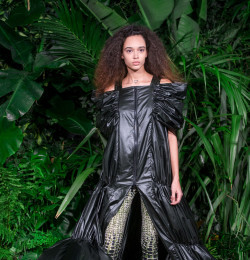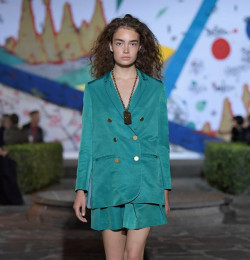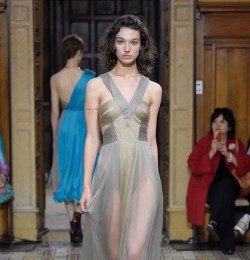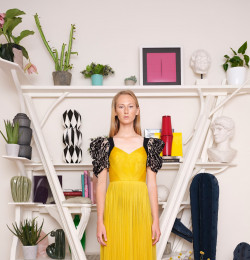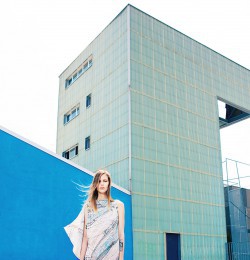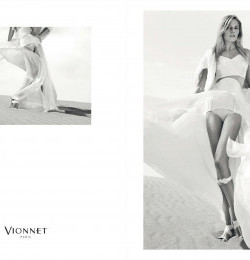

Vionnet
West Hollywood, Ca 90048
USA
About
founded by
Madeleine Vionnet
belongs to
Mateo Marzotto
about
The House of Vionnet opened in 1912 at 222, Rue de Rivoli. Madeleine Vionnet provided one-third of the financing while the remaining investment was supplied by one of her client, Germaine Lilas, Henri's Lillas' daughter, the owner of the Parisian department store Bazar de l'H�tel de Ville (BHV). In 1914, when World War I started, Madeleine Vionnet closed the house and set off to visit Rome.
In 1919, the house reopened after the war. Mr. Martinez de Hoz, an Argentinian, joined Mr. Lillas as main shareholder of the house. During the same period, Thayaht, a futurist artist, created Vionnet's logo and started designing textiles, clothing and jewelry for the house.
In 1922, Th�ophile Bader, owner of the Galeries Lafayette, joined current shareholders Mr. de Hoz and Mr. Lillas in a new venture called Vionnet & Cie and became the majority shareholder. Few months later, on April 15, 1923, Vionnet's new premises opened at 50, Avenue Montaigne. The so-called "Temple of Fashion", a collaboration of architect Ferdinand Chanut, decorator George de Feure and crystal sculptor Ren� Lalique, incorporated a spectacular Salon de Pr�sentation and two boutiques: a fur salon and a lingerie salon. 1923 was a very active year for the house: Vionnet co-founded the first anticopyist Association (L�Association pour la D�fense des Arts Plastiques et Appliqu�s), hosted in the House�s premises and directed Vionnet & Cie�s managing director; Vionnet introduced fingerprinted labels to authenticate models (each garment produced in Vionnet studios bears a label featuring Vionnet�s original signing and an imprint of Vionnet�s right thumb); Vionnet & Cie entered into a distribution arrangement with Charles and Ray Gutman, who own Charles & Ray Ladies� Tailors and Importers in New York City. In November, the first collection of Vionnet clothing shown at Charles and Ray was an enormous success.
In 1924, architect and designer Boris Lacroix was appointed art director of the House. From 1924 to 1937, he designed furniture, logos, printed textiles, handbags, accessories and took part in the planning of Vionnet�s perfumes.
In the mid-twenties, the house was extremely active in the USA. In 1924, Vionnet & Cie signed an exclusive production and distribution agreement with Fifth Avenue retail store Hickson Inc. In February 1924, the Vionnet New York Salon opened at Hickson and an exclusive collection of gowns was presented. In 1925, Vionnet & Cie was the first French couture house to open a subsidiary in New York: Madeleine Vionnet Inc., located at 661 Fifth Avenue. The salon sold �one-size-fits-all� designs with unfinished hems, to be adjusted to fit individual clients. Vionnet also produced ready-to-wear designs for US wholesale. Arguably the first pr�t-�-porter ever made from Paris haute couture, the garments bore a label signed by Madeleine Vionnet along with �Repeated Original� as a trademark name.
During this time, in France, Vionnet opened a salon in the Grand Casino at Biarritz. in 1925, the house launched its first limited edition perfume comprising four fragrances named alphabetically: �A�, �B�, �C� and �D�. The geometrical bottle was designed by Boris Lacroix while the scent was made in collaboration with the House of Coty.
In 1927, Vionnet opened a school within her couture house to teach apprentices how to create clothing on the bias cut. In 1929, Vionnet led the establishment of a new anticopyist association, the P.A.I.S., directed by Armand Trouyet, managing director of Vionnet & Cie.
In 1932, the House acquired a new five-storey building at 50, Avenue Montaigne housing 21 workshops along with a clinic (equipped with both doctors and dentists) and a gymnasium. At this time, the house employed 1,200 seamstresses. Vionnet was one of the most important Parisian fashion houses of the 1930s. When WWII approached, a reorganization of the House was contemplated. Eventually, Vionnet decided to close her House. On August 2, 1939, Madeleine Vionnet showed her farewell collection.
In 1952, years after the closing of her house, Madeleine Vionnet donated most of her designs to the archives of the UFAC (today part of the Mus�e de la Mode et du Textile in Paris) including 120 dresses from 1921 to 1939.
In 1988 the Vionnet fashion house was revived by the Lummen family and specializes primarily in accessories and luxury goods.
Plans to reintroduce new ready-to-wear collections were first rumoured in early 2000 and really took shape in February 2003 when Sheikh Majed Al-Sabah, owner of Villa Moda, a Kuwaiti luxury department store, announced to the press a strategic collaboration with the house. New Vionnet collections were to be designed under the helm of Maurizio Pecoraro but due to the Iraq war, the relaunch was delayed.
In Autumn 2006 it has been announed that Sophia Kokosalaki will be taking over the creative design for the classic house of Vionnet. She is thrilled to death and is deep in the archives to absorb everything she can of the spirit of the great designer.
The first new collection was unveiled to the public in December 2006 within the US edition of Vogue. From early 2007, this first new Vionnet collection became exclusively available in the house atelier in Paris and within Barneys New York flagship stores in the USA. Sophia Kokosalaki designed one more collection for the label before to be replaced in May 2007 by Marc Audibet, in an unexpected move from the house.
Marc Audibet, appointed as artistic advisor, presented its sole and unique collection for the house in October 2007. However, in a new unexpected move, Marc Audibet resigned from the house who then appointed a pool of designers, without revealing their identities. In February 2008, Arnaud de Lummen told Women's Wear Daily that he wanted the focus to be on the label's expansion and not on its designers: "Vionnet doesn't need to be associated with a designer's name, it's an institution."
From 2006 to 2008, Vionnet produced made-in-France "demi-couture" collections closed to haute-couture in the prices featured and the techniques and textiles used. Vionnet involved historical partners of the house, such as the couture embroiderer Lesage.
On February 24, 2009, Matteo Marzotto announced the acquisition of the label and the creation of a new and independent structure in Milan where Vionnet is now operated. Matteo Marzotto, former General Manager and President of Valentino SpA, is one of the heirs of the Marzotto Group, a powerful textile group established in Italy since 1836. Matteo Marzotto also announced that some additional strategic development is to be provided by Gianni Castiglioni, CEO of the fashion brand Marni.
Vionnet is now designed by Rodolfo Paglialunga who, prior to Vionnet, spent 13 years as a designer of womenswear at Prada, and the previous four years at Romeo Gigli
Who Wears It
Marlene Dietrich, Katharine Hepburn, and Greta Garbo
Perfumes
Official Social Media
Latest Vionnet Advertisements

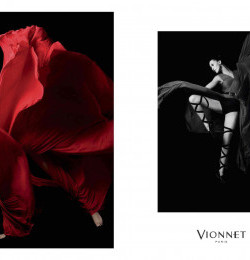
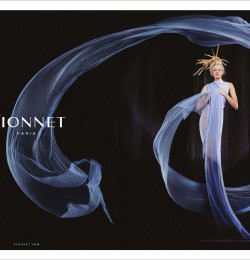
Look Books from Vionnet
Vionnet Fashion Shows
